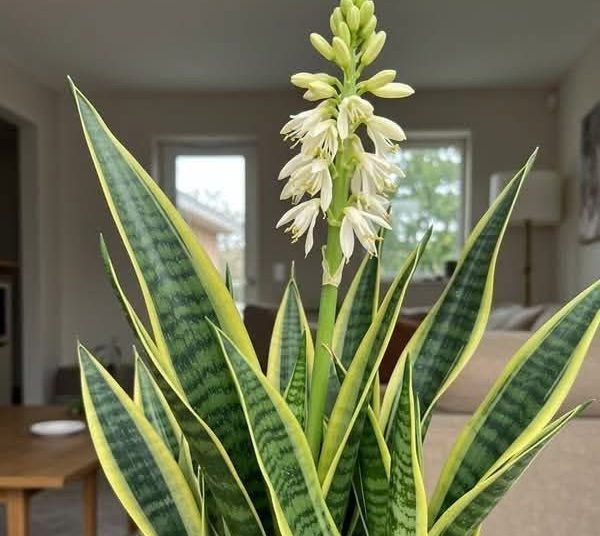Snake plants (Sansevieria), also known as mother-in-law’s tongue, are loved for their resilience and striking sword-shaped leaves. While most people grow them for foliage, many don’t realize that snake plants can also produce beautiful, fragrant flowers. These blooms are rare, but with the right care and environment, you can learn how to make a snake plant bloom at home.
What Do Snake Plant Flowers Look Like?

Snake plant flowers grow in clusters along a tall flower stalk, often reaching up to three feet high. The blooms are usually creamy white or pale green, with a delicate lily-like fragrance. Interestingly, many snake plants only bloom under stress or in specific conditions, making it a special event when they do.
Why Snake Plants Rarely Bloom
In their native African habitat, snake plants flower more often. Indoors, however, they tend to focus on leaf and root growth rather than reproduction. The main reasons they don’t bloom are:
- Stable indoor conditions (not enough environmental stress to trigger flowering)
- Overwatering (causing root rot instead of healthy growth)
- Insufficient light (limiting the plant’s ability to build energy for blooms)
How to Encourage a Snake Plant to Bloom
If you’re wondering how to get a snake plant to bloom, here are the best methods:
1. Provide Bright, Indirect Light
Snake plants tolerate low light, but they need plenty of bright, indirect sunlight to bloom. Place your plant near an east- or south-facing window, but avoid harsh direct rays that can scorch the leaves.
2. Create Mild Stress
A surprising fact: snake plants often bloom when they are slightly “neglected.” If the plant becomes a little root-bound in its pot, it may shift energy into flowering. Avoid frequent repotting, and let it grow snugly in its container.
3. Water Sparingly
Overwatering is the number one killer of snake plants. To encourage blooms, water only when the soil is completely dry. In spring and summer, this might be every 2–3 weeks; in winter, even less. Proper watering reduces stress and mimics their natural dry-season cycle.
4. Fertilize During Growing Season
During spring and summer, feed your snake plant once a month with a balanced houseplant fertilizer diluted to half strength. Extra nutrients help the plant store energy needed for flower production. Avoid fertilizing in fall and winter.
5. Maintain Ideal Temperature
Snake plants thrive between 18–27°C (65–80°F). Warmer temperatures encourage faster growth and may increase the chances of blooming. Avoid cold drafts, which can damage the plant.
6. Be Patient
Even with perfect care, snake plants don’t bloom on a predictable schedule. Sometimes it takes years. Patience, consistency, and the right environment are the real secrets.


What to Do After Blooming
After your snake plant blooms, the flower stalk will eventually dry out. You can cut it off at the base to keep the plant tidy. Sometimes, flowering may trigger new shoots (pups) to grow, giving you more plants to propagate.

Frequently Asked Questions About Snake Plant Flowers
1. Do snake plants bloom indoors?
Yes, snake plants can bloom indoors, though it’s uncommon. They need bright light, minimal watering, and sometimes a bit of “stress” (like being root-bound) to trigger flowering.
2. How often do snake plants flower?
There’s no fixed schedule—some may flower once in several years, while others might never bloom indoors. It depends on light, care, and environmental conditions.
3. Is it bad if a snake plant flowers?
Not at all. A flowering snake plant is actually a sign that your plant is mature and healthy enough to produce blooms. After flowering, the plant will continue to grow as usual. The only thing to note is that the flower stalk can take energy from the plant, so once it dries, trim it off to encourage new leaf and pup growth.
4. Do snake plant flowers smell?
Yes, the flowers usually release a sweet, jasmine-like fragrance, especially in the evening. Some people love it, while others may find it strong.
5. Will my snake plant die after flowering?
No. Unlike some succulents that die after blooming (such as agave), snake plants will keep growing after flowering. In fact, many will produce new shoots afterward.
Final Thoughts
A blooming snake plant is a rare and rewarding sight, filling your home with both beauty and fragrance. By providing bright light, practicing controlled watering, and allowing your plant to grow slightly root-bound, you can increase your chances of witnessing this special event. For anyone curious about how to make a snake plant bloom, the secret lies in patience and consistency—when your plant finally blossoms, it will be well worth the wait.
















